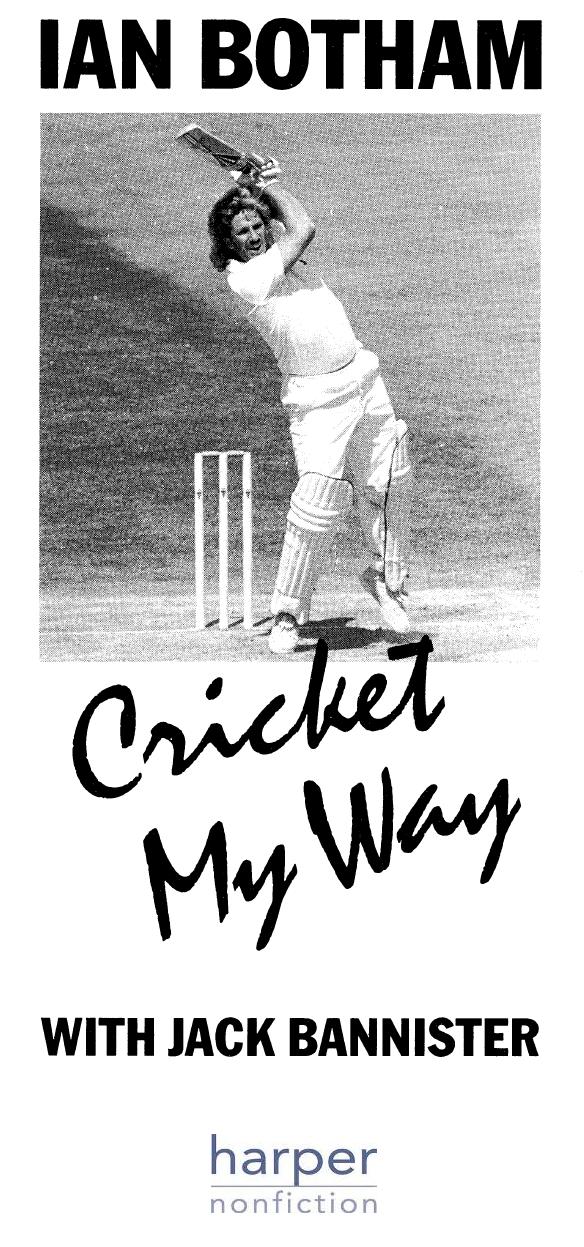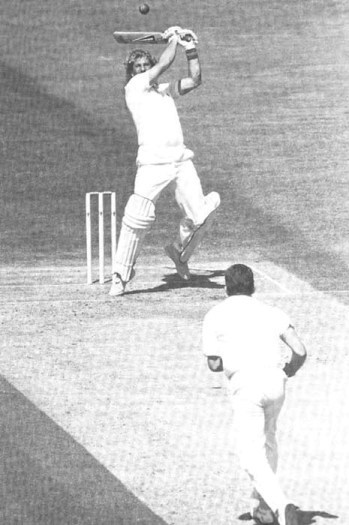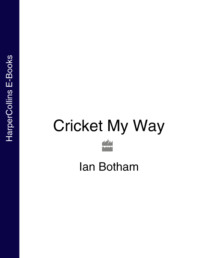
Полная версия
Cricket My Way




HarperNonFiction
A division of HarperCollinsPublishers Ltd. 1 London Bridge Street London SE1 9GF www.harpercollins.co.uk
First published in 1989 by William Collins Sons & Co. Ltd
Reprinted 1989, 1990
© Newschoice Ltd and Ian Botham 1989
Photographs courtesy of Adrian Murrell/All-Sport and Patrick Eagar
Illustrations by John Scorey
A catalogue record for this book is available from the British Library
Some images were not available for the electronic edition
The Author asserts the moral right to be identified as the author of this work
A catalogue record for this book is available from the British Library
All rights reserved under International and Pan-American Copyright Conventions. By payment of the required fees, you have been granted the non-exclusive, non-transferable right to access and read the text of this ebook on-screen. No part of this text may be reproduced, transmitted, down-loaded, decompiled, reverse engineered, or stored in or introduced into any information storage and retrieval system, in any form or by any means, whether electronic or mechanical, now known or hereinafter invented, without the express written permission of HarperCollins ebooks
HarperCollinsPublishers has made every reasonable effort to ensure that any picture content and written content in this ebook has been included or removed in accordance with the contractual and technological constraints in operation at the time of publication
Source ISBN: 9780002183153
Ebook Edition © JANUARY 2017 ISBN: 9780007513086
Version: 2017-01-18
Table of Contents
Title Page
Copyright
Preface
Part One: How I Play My Cricket
Part Two: Batting
1. Holding The Bat
2. The Start Of An Innings And How to Build It
3. The Classic Shots
4. How I Play Slow Bowling
5. Unorthodox Strokes
6. Defensive Batting
Part Three: Bowling
1. Bowling Techniques – An Introduction
2. Held Placings
3. Seam Bowling
4. Slow Bowling
5. Bowling to Left-Handers
Part Four: Fielding
1. Approach
2. Wicket-Keepers
Part Five: Captaincy
1. Honesty
2. Dealing with Pressure
3. Dealing with Players
4. One-Day Matches
Part Six: General Knowledge
1. Why I Play The Game The Way I Do
2. Final Message
Keep Reading
Index
About the Author
About the Publisher

‘Give me a challenge and I’ll take it on.’ In this instance against the Australians – perhaps my favourite opponents.
Preface
The Headingley electronic scoreboard of 18 July 1981 flashed that historic bookmaking quotation of 500–1 against England beating Australia – and that is why I am writing this book. Not just to re-hash that famous England win, but to try to explain to all cricketers why they should never ever accept the result of any match as a foregone conclusion.
Cricket is just not like that, and although that Test match provided a once-in-a-lifetime fairy story ending, I have played in plenty of other matches where a game has suddenly been tilted unexpectedly because one player had the guts to attack against all the odds.
My approach to cricket is simple. Give me a challenge and I’ll take it on. If there’s no challenge, then I try to find one. I know my strengths – and weaknesses – and I have always set goals for myself from school right through to Test cricket. And when I’ve achieved something I set out to do, I immediately re-set the goalposts. That is the best way I know to sustain enthusiasm, and no matter at what level you play the game, there is so much more fun to be got out of cricket, if you give yourself something really demanding to aim at.
Never mind if you fail. Part of the point of sport is that there are winners and losers. What you have to do is to convince yourself that you are going to be a winner more often than not, and you’ll be surprised at what sometimes happens. In this book I shall try to explain the correct technical approach to every part of the game – batting, bowling, fielding, wicketkeeping, captaincy – but my main message will be much more fundamental.
The real basis of any cricketer’s success has got to be attitude, and I want to show how properly used aggression can help any player in the world.
From my early schooldays at Milford Junior School and Bucklers Mead School, I decided I wanted to be the best, and so I had to think, talk and play like the best. I am naturally aggressive – in fact, my whole way of life is based on aggression, mostly I hope of the right sort.
Like lots of kids, I wanted to bat and bowl so that I was always in the game, but most allrounders soon decide that is too much like hard work and so become batsmen who bowl, or the other way around. But by sticking at it, I gave myself the extra opportunity to be centre stage throughout a match with two strings to my bow.
The first actual coaching I remember was from a teacher, Ken Hibbert, when I was about eight or nine. It was all to do with the grip, and after all – just like golf – if you get the grip right you’ve got chances. Get it wrong, and just forget it, because it will lead to a repetition of basic errors which will prevent any consistent success.
Like every part of cricket, the best is the simplest. The bat was laid down in front of me, and I was told to pick it up as though I was going to chop a piece of wood. Instinctively my hands came together. That is, quite simply, the most important tip of all to any young batsman. It doesn’t really matter whether the hands are at the top or the bottom of the handle, as long as they are together.
I soon found I could hit the ball hard and often, and even when I came into contact with my first county cricketers, nobody tried to alter my basics – simply because they were correct.
When I was about 11, Dad captained the Westlands 2nd XI – after playing a lot for the first team – and I used to travel with him. When certain guys used to go to the Taunton nets, I went with them, and I well remember Kenny Palmer there. He used to spend a lot of time encouraging me in a net by dragging me off on my own and throwing a few balls to me. I think he had a soft spot for me, and in fact he still does.
Remember the scene at Headingley against Pakistan in 1987 after their wicket-keeper Salim Youssuf claimed that ‘catch’. Kenny was at point and came in like the speed of light to defuse what could have been quite an incident. I like to think he did that because he knows I have always tried to play the game in the right way – but more of that later.
So it was Dad, Ken Hibbert and Ken Palmer early on, and then Harry Sharpe, Tom Cartwright and Brian Close later, who were the main influences on my career. I still ring Tom up, because he taught me all the basics in bowling, when not many people saw anything in me in that department. For instance, when I went on to the Lord’s Ground Staff in 1972 at the age of 16, their attitude was that I was only a batsman. Harry Sharpe thought I might be a bowler, but Len Muncer didn’t.
They had a lot of specialist bowlers so I was naturally regarded as a batsman who could bowl to members. My reaction was ‘I’ll show ’em.’ So when I went back to Somerset and Tom offered to show me a few things, I listened – another example of working out for yourself who and what is right for you. That is something nobody can teach you, but I shall try to explain certain of the basics which should never alter. As an example, Tom taught me how to swing the ball both ways, although I had always found the outswinger came quite naturally to me.
That is my first tip. Decide on what you want, and then go for it. Don’t be put off by failure or criticism.
I soon found out that, done properly, cricket is a simple game. I was lucky enough to start with because I found it natural to hold the bat and the ball correctly, and no matter what anyone else says, the real secret of my success is that I play the game in a much more orthodox way than most people realize. For instance, I hit mainly straight, with great emphasis on my leading left arm and hand. With the ball I have worked hard on my hand and wrist action, which is why I hit the seam so often and can also swing the ball. In the slips, I may look inattentive sometimes, and not everyone agrees with the way I stand with hands on knees, but I stand still, and concentrate on each ball as hard as I can.
Once you know the basics, the rest is down to attitude. Create a belief in yourself, and stay true to it even through the bad spells that come to everyone.
Cricket is a great leveller, but don’t let it push you into a routine mould where you suddenly forget to aim for the top.
To sum up my own attitude, which I always try to carry into my batting and bowling, my philosophy is ‘Where can I score runs off the next ball?’ whereas too many batsmen – even county players – seem to think ‘How can I avoid being out to the next ball?’ And with bowling my first thought is ‘How can I take a wicket with this ball?’ compared with the reverse approach of ‘How can I best bowl a maiden?’
Many people see me as a spontaneous cricketer. I am not completely that, because that would make me just as much a blinkered cricketer as someone whose approach is too cautious. I never am blinkered; I am always trying to work out how best to attack the opposition.
There is a huge difference between correct and incorrect techniques. There is just as big a difference between sensible, controlled aggression and the other sort.
This book is to explain those differences.
PART ONE HOW I PLAY MY CRICKET


Happy days at Somerset during my 60-ball century v Worcester, at Westonsuper-Mare, 1986.
People are always asking me if I ever had any coaching or instruction. Of course I did, but where I was lucky was that nobody ever tried to meddle with whatever came naturally to me.
The main message of this book is to listen to all the advice offered to you, because it is well meaning, and then decide what will work for you.
The first two real influences on me were my Dad, Les, and then a sports master called Ken Hibbert at Milford Junior School. Dad used to throw a few balls to me when I was only three or four, and as long as I played straight, he never attempted to force anything else on me.
One example of how vital the proper advice can be came to me at the tender age of nine. I was playing against Westfield – another junior school in Yeovil – and I nailed a left-hander right in front of the stumps with a big inswinger to him. Because I didn’t know what leg before wicket, l.b.w., meant, I didn’t appeal. At the end of the over Ken Hibbert, who was umpiring, asked me: ‘Why didn’t you appeal?’ I said, ‘For what? He didn’t hit it and I didn’t bowl him.’ Of course I had heard about ‘l.b.w.’ but I simply didn’t have a clue what it meant.
Ken only explained to me once, and from then on I got a packet of them – mostly with my away swinger which was my natural ball.
Looking back on my progress on to the Somerset staff in 1973, I now realize that I was lucky enough to strike the right balance between going my own way, and absorbing the right sort of advice and coaching which was aimed at maximizing my natural talents, but not at the expense of stifling my natural aggressive approach with bat and ball.
I have always tried to hit the ball hard, and I have always tried to take wickets. Now let me try to pass on the tips which have helped me most.
All of them won’t suit every young cricketer, just as every piece of advice given me was not taken, but I guarantee that if I can get over my attacking philosophy, any cricketer can only benefit from what I have learned. For instance, I have tried to be such a complete allrounder that I could justify selection with either bat or ball.
Trevor Bailey has gone on record as saying, ‘Botham is our most spectacular, dynamic and suecessful allrounder in Test cricket this century. His only serious rival is the immortal W. G. Grace from the previous one.’

Hooking Imran Khan, Fourth Test, England v Pakistan, Edgbaston, July 1987. If you are going to hit the ball, hit it hard.
What a double billing that makes – ‘Grace & Botham’ – or should I insist on alphabetical order!
I have often been criticized for attacking too much with the ball, but the plain truth is that I have always been prepared to gamble a few runs away for a wicket, whereas some bowlers simply do not have that attacking streak in their make-up. For instance, Mike Hendrick was a fine bowler, with all the attributes of line and length, stemming from a lovely high, sideways action. Yet in 23 Tests for England he never took five wickets in an innings.
My bowling is always aimed at taking wickets, and I am always prepared to try a slower ball, or a bouncer. As well, of course, as using the width of the return crease to increase the batsman’s problems with a different angle of delivery.
There are so many variations for a seam bowler to try, and he should never settle for containment, even on a flat pitch. That is, unless the state of the game calls for a ‘mean spell’.
With the bat, when I attack – which is most of the time – I reckon the safest way is to play and hit straight. My margin of error is greater because every time a batsman plays with a crooked bat, he is reducing his area of contact with the ball.
Again Trevor Bailey was kind enough to comment: ‘In my career, I encountered very few hitters, and nobody in the same class as Ian Botham. His straight back stroke, whether used for defence or offence, is mainly with the full face, while his feet are in the correct position and his downswing from the top of the full backs wing is copybook.’
I also remember Alan Smith, the England manager of the 1981 tour of the West Indies which I captained, telling me that I could play as straight as anyone in the game, and that was my real strength.
Before I move on to the detail of technique, let me summarize my attitude, which I have had through every level of cricket I have played: I only want to win, and am prepared to gamble when others are not. Sometimes it comes off and my side wins a match from nowhere, and then I’m a hero in the public’s eye. But sometimes, my side loses a match we might have drawn, and then I get plenty of stick. I only want to win and hate losing. Coming second is nothing; but you have to lose sometime, and then comes the next test of character.
Some dressing rooms become morgues, and I cannot understand that – not if everyone has done his best. I try to use defeat as a spur for the next game. My motto is to have a drink with the enemy and get on with life. I always wanted to be a winner. That is why my approach is based on an unshakable confidence in my own ability never to back off, and always to attack when there is the slightest chance of affecting the course of a match.
Even as a kid, I would not compromise my approach, and because I have never accepted the idea of defeat, we pulled through.
It sounds so obvious to say ‘never give up’, but so often the temptation is overwhelming to accept the cards dealt you. Resist it always, and you will be amazed at how much more you will enjoy the game.
BOTHAM ON THE ATTACK
A fair example of that is one of my first games in 1974 in the Benson and Hedges quarter-final on June 12th at Taunton against Hampshire.
‘What a glorious twelfth it turned out to be, even though it cost me a few broken teeth from an Andy Roberts bouncer. Needing 183, we were 113 for 8, with Roberts still to bowl seven overs.
‘The game was gone – nearly. I notched a 45 not out, we won the game, and the lesson is there for all to see.’
PART TWO BATTING

Конец ознакомительного фрагмента.
Текст предоставлен ООО «ЛитРес».
Прочитайте эту книгу целиком, купив полную легальную версию на ЛитРес.
Безопасно оплатить книгу можно банковской картой Visa, MasterCard, Maestro, со счета мобильного телефона, с платежного терминала, в салоне МТС или Связной, через PayPal, WebMoney, Яндекс.Деньги, QIWI Кошелек, бонусными картами или другим удобным Вам способом.


